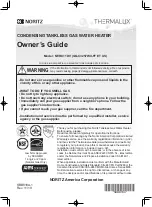
lp-672 Rev. 000 Rel. 002 Date 10.3.18
9
This water heater has a condensate disposal system that may freeze
if exposed to sustained temperatures below 32
o
F. Precautions
should be taken to protect the condensate trap and drain lines
from sustained freezing conditions. Failure to take precautions
could result in property damage, severe personal injury, or death.
The service life of the water heater’s exposed metallic surfaces,
such as the casing, as well as internal surfaces, such as the heat
exchanger, are directly influenced by proximity to damp and
salty marine environments. In such areas higher concentration
levels of chlorides from sea spray coupled with relative humidity
can lead to degradation of water heater components. Take local
installation conditions into consideration before installing to
prevent premature water heater failure.
2. Check for nearby connections to:
•
System water piping
•
Gas supply piping
•
Electrical power
•
Condensate drain
3. Check area around heater. Remove any combustible materials,
gasoline, and other flammable liquids.
Failure to keep the water heater area clear and free of combustible
materials, liquids, and vapors can result in substantial property
damage, severe personal injury, or death.
4. Gas control system components must be protected from dripping
water during operation and service.
5. If the heater is to replace an existing heater, check for and correct
any existing system problems, such as:
• System leaks
• Location that could cause the system and heater to freeze
and leak
Do not connect the water heater to any heating systems or
components that have been previously used for non-potable
applications.
Do not introduce toxic chemicals, such as antifreeze or water heater
treatments, into the water heater or any piping meant for potable
water purposes.
Ensure that all piping and components connected to the water
heater are suitable for potable water applications.
Do not use this water heater for space heating applications.
Circulators suitable for DHW applications must be used.
C. Clearances for Service Access
See Figure 1 and Table 6 for recommended service clearances. If these
minimum clearances are not provided, it may not be possible to service
the water heater without removing it from the space.
B. Leveling
In order for the condensate to properly flow out of the collection
system, the area where you locate the heater must be level. Location
must also fully support the weight of the filled water heater.
NOTE:
When installing in a minimum clearance location, it may not be
possible to read or view some product labeling. It is recommended to
make note of the heater model and serial number.
To conserve water and energy insulate all water piping, especially
the hot and recirculation water lines.
Table 6 - Minimum Installation and Service Clearances
Recommended Service and Proper Operation Clearances
Top
36 in. (900 mm)
Back
5/8 in. (15.9 mm)
Front
24 in. (609.6 mm) or more
Right Side
6 in. (150 mm)
Left Side
Bottom
12 in. (304.8 mm)
NOTE:
This appliance is approved for zero clearance to combustible
construction.
NOTE:
If the water heater is installed in a narrow space or corner,
ensure that there is sufficient space for service.
NOTE:
If you do not provide the minimum clearances shown in Table
6 and Figure 1 it might not be possible to service the heater without
removing it from the space.
NOTE:
In multiple water heater installations, ensure a minimum
clearance of 36” from the top of one water heater to the bottom of the
next water heater, and a minimum clearance of 10” from the side of
water heater to the next water heater.
All water heaters eventually leak. Locate the water heater
where any leakage from the relief valve, related piping, tank, or
connections will not result in damage to surrounding areas or
lower floors of the building. Any water heater should be installed
in such a manner that if it should leak the resulting flow of
water will not cause damage to the area in which it is installed.
National Plumbing codes require a drain pan for any water heater
installation. Such a drain pan must have a clearance of at least 1.0”
(2.5 cm) greater than any point on the water heater’s outer jacket
and must be piped to an adequate drain. Leakage damages ARE
NOT covered by warranty. Failure to install a drain pan is the sole
responsibility of the owner and/or installer. Reference UPC 2000
(Uniform Plumbing Code) Section 510 - Protection from Damage
or IPC 200 (International Plumbing code) Section 504 - Safety
Devices. Leakage damages ARE NOT covered by warranty.
In addition, water leak detection devices and automatic water
shutoff valves are readily available at plumbing supply houses. IT
IS HIGHLY RECOMMENDED BY THE MANUFACTURER TO INSTALL
WATER LEAK DETECTION DEVICES AND AUTOMATIC SHUTOFF
VALVES IN ANY WATER HEATER INSTALLATION WHERE A LEAKAGE
OF WATER COULD RESULT IN PROPERTY DAMAGES.
• Incorrectly sized expansion tank
6. Clean and flush system when reinstalling a heater.
Do not locate the water heater where it will be exposed to prevailing
winds.
Moisture will be produced by the exhaust vent. Take precautions
when determining water heater location. Moisture may fall from the
vent termination to the ground and turn to ice in freezing conditions.
Moisture or ice can produce a hazardous condition.
Failure to follow these instructions could result in substantial
property damage, serious personal injury, or death.










































